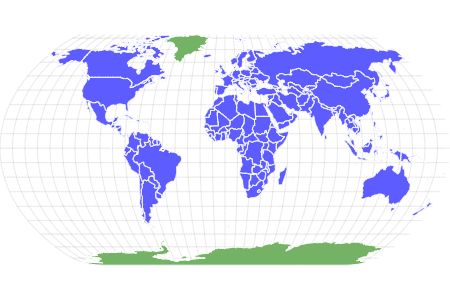Falcon
The falcon is faster than any other animal on earth, both on land and in the air
Advertisement
Falcon Scientific Classification
Read our Complete Guide to Classification of Animals.
Falcon Conservation Status
Falcon Facts
- Main Prey
- Birds, Rabbits, Bats
- Fun Fact
- The falcon is faster than any other animal on earth, both on land and in the air
- Distinctive Feature
- Sharp, pointed beak and aerodynamic body shape
- Wingspan
- 74 to 120 cm
- Incubation Period
- Approximately one month
- Habitat
- High areas like mountains and cliffs
- Predators
- Human, Eagles, Owls, Wolves
- Diet
- Carnivore
- Lifestyle
- Solitary
- Favorite Food
- Birds
- Type
- Bird
- Average Clutch Size
- 3
- Slogan
- The fastest creatures on the planet!
- Nesting Location
- Tree holes, cliffs, and ledges
- Age of Molting
- Varies with each species
- Migratory
- 1
View all of the Falcon images!
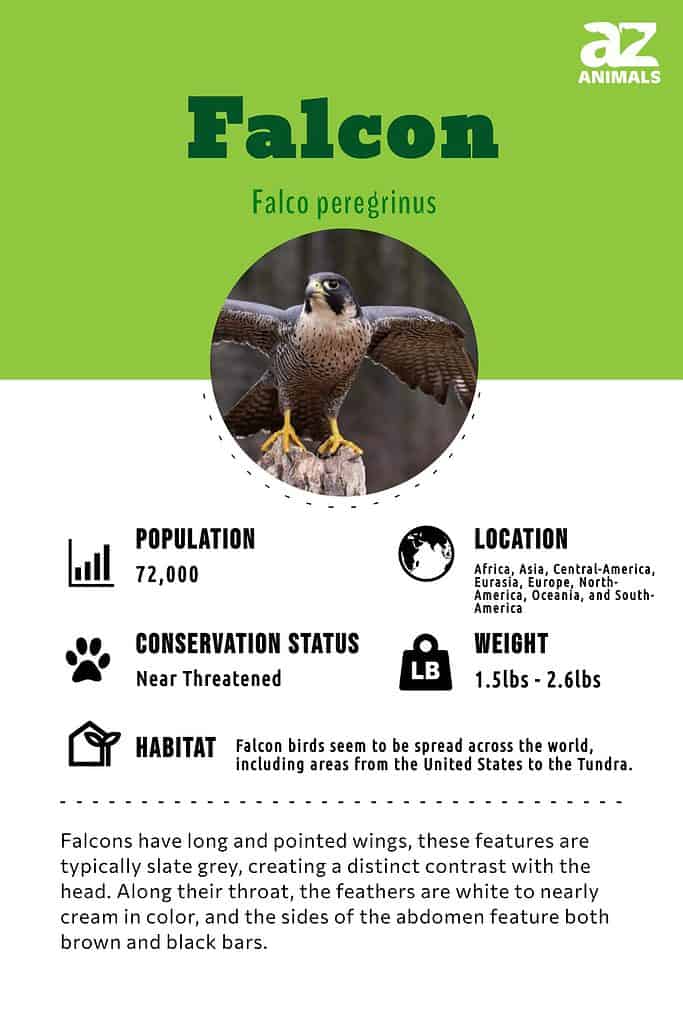
The falcon bird is faster than any other animal on earth, both on land and in the air!
Known for their precision and speed, the falcon bird seeks out food like any bird of prey.
Falcons, rather than being one species of bird, actually include 40 different species with specific traits that make each one unique.
Even with many different types of falcons, this family of birds is wholly considered to be the fastest-living animal. Peregrine falcons have been recorded diving at speeds of over 200 miles per hour!
Falcon birds have a close relationship with hawks, possessing the same ferocity and quick reactions. Their streamlined bodies display slender, pointed wings. With their agility, these birds can often snatch their prey while they are in mid-flight.
Falcon vs. Hawks
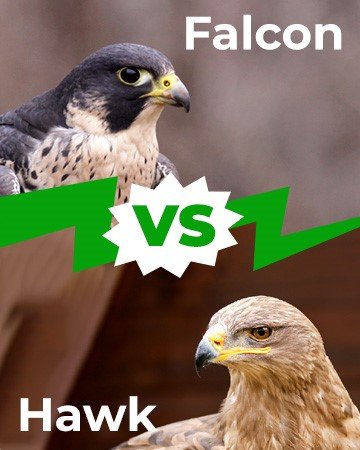
As close as falcons may be to hawks, there are many characteristics to distinctly tell them apart. Falcon birds may have broad and long wings, but the hawk has significantly shorter wings, which is the easiest way to tell them apart in the air. Despite their wingspan, hawks tend to be larger than falcons.
Speed is another major difference between falcons and hawks. Falcon birds have incredible speed, while hawks can’t match up. They are not nearly as fast, preventing them from gliding through the air in the same way.
Catching prey is also different between the birds. While falcons go after their prey with their beak, the hawk will catch it with their claws.
Different Types of Falcons
- Common kestrel
- Peregrine falcon
- Merlin
- Gyrfalcon
- Saker falcon
- American kestrel
- Eurasian hobby
- Amur falcon
- Prairie falcon
- Lanner falcon
- Black falcon
- Barbary falcon
- Brown falcon
- Lesser kestrel
- Eleonora’s falcon
- Bat falcon
- Aplomado falcon
- Fox kestrel
- Laggar falcon
- Red-necked falcon
- Australian hobby
- Taita falcon
- Banded kestrel
- Malagasy kestrel
- Seychelles kestrel
- Dickinson’s kestrel
- Red-footed falcon
- Grey falcon
- New Zealand falcon
- Sooty falcon
- Orange-breasted falcon
- Nankeen kestrel
- Mauritius kestrel
- Greater kestrel
- Spotted kestrel
- Grey kestrel
- Oriental hobby
- African hobby
Evolution and Origins
Falcons evolved from a generalized raptors from 50 to 35 million years ago during the Eocene Epoch. The American Falco modern species belongs to the peregrine group. The evolutionary process was successful through what was known as the Holarctic. They originated possibly around central Eurasia.
Additionally, through analysis of the genomes, scientists determined that Peregrine and Saker’s falcons share a common ancestor about 2.1 million years ago. Although, compared to other birds of prey, the fossil record of the falcons isn’t as available.
Amazing Falcon Bird Facts!
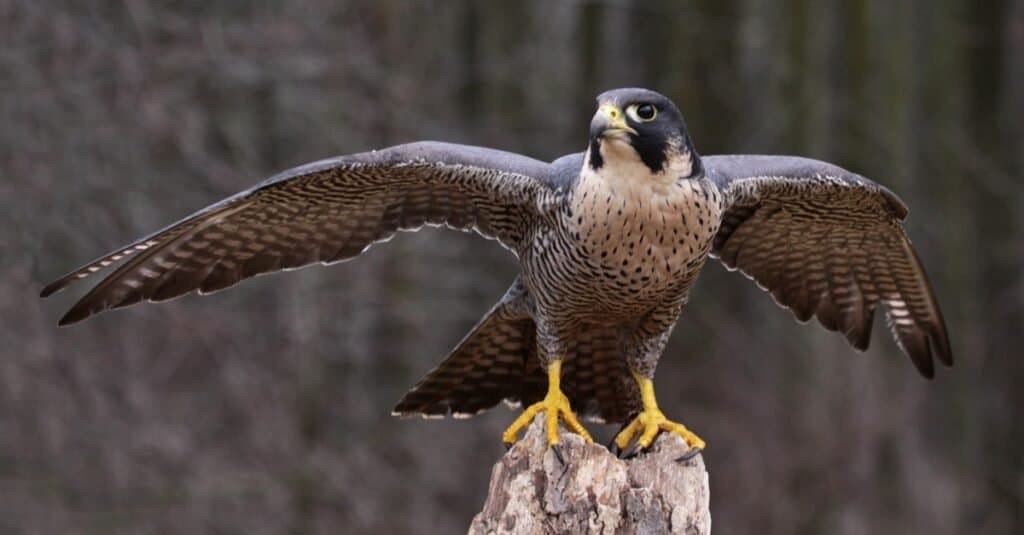
A Peregrine Falcon (Falco peregrinus) spreads its wings while perched on a stump. These birds are the fastest animals in the world.
©Chris Hill/Shutterstock.com
- The fastest animal on earth is the peregrine falcon, which reaches speeds of up to 242 mph. It is nearly four times the speed of the fastest land animal (which is the cheetah).
- These birds can catch their food while they are in mid-flight with their beaks.
- Falcons have incredible eyesight, which is why they are able to capture their food so easily. They can seek both regular color and ultraviolet color, exceeding the range of humans.
- The cardiovascular system of the falcon bird allows them to beat its wings at a rate of 5 m/s.
You can read more incredible facts about falcons.
Where to Find Falcons
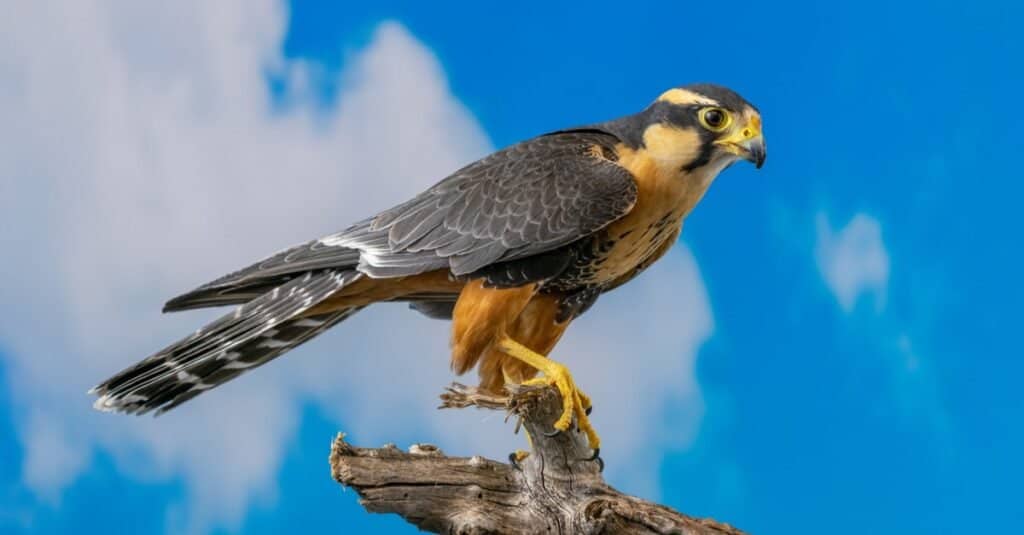
During hunting Aplomado falcon pairs often pass food to each other in flight.
©JayPierstorff/Shutterstock.com
Falcon birds seem to be spread across the world, including areas from the United States to the Tundra. Each species seems to have its own area that it prefers to reside in. For example, the American kestrel will migrate throughout the contiguous United States, sharing this home with peregrine falcons. They will also travel as far as Alaska and Hawaii.
Peregrine falcons like to travel even further to every continent, and even feel comfortable in the desert. However, as well-accustomed as they are too extreme temperatures, the only area that this bird does not inhabit is Antarctica.
In their habitats, the falcon bird will make their nest in tree holes, as well as on cliffs and natural ledges.
Scientific Name
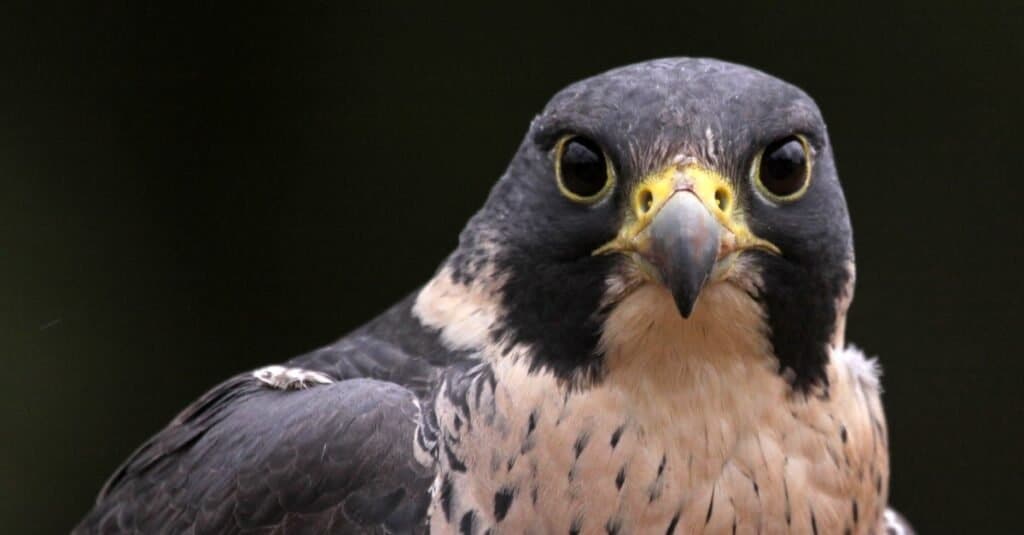
Types of Falcon Birds
©Chris Hill/Shutterstock.com
Falcons go by the scientific name Falconiformes. They belong to the kingdom Animalia and Phylum Chordata. Their class is called Aves and the order is called Falconiformes. Their genus is called Falco.
The name “hawk” has French and English origins, coming from the word “faucon.” The Latin word for the bird – falconem – comes from the word falx, named for the similarity that their physical characteristics – like their talons, beak, and wings – to a curved blade.
The Bird’s Size, Appearance, and Behavior
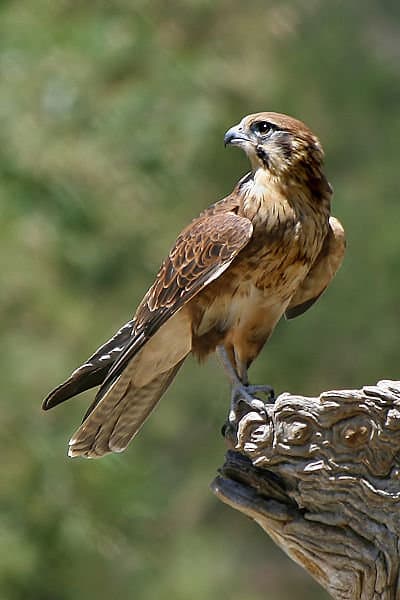
Falcon
©John O’Neill / Creative Commons – Original
Falcon birds can range from 13 to 23 inches, weighing approximately 1.5 to 3.3 pounds. Most of these birds of prey ultimately range from small to medium size, and their head is adorned with a black crown of feathers. This blackness extends to their nap and wedge as well, connecting the colors to look like a helmet over the bird’s head.
With long and pointed wings, these features are typically slate grey, creating a distinct contrast with the head. Along their throat, the feathers are white to nearly cream in color, and the sides of the abdomen feature both brown and black bars.
The falcon bird tends to be solitary, primarily coming together during the mating season and no other times of the year. During the rest of the time, these birds will spend the days either resting at the tops of tall trees or hunting down food. The majority of species will hunt in the daytime, taking any opportunity with the sunlight (even at dusk and dawn) to hunt.
Falcon birds will migrate seasonally, seeking out a milder region when the weather is increasingly cold during the winter. The migratory species will often go to Central or South America, though some will only journey to the southern United States.
Interestingly, some of them do not migrate at all. When it comes to their home, falcons are incredibly territorial. They will fight and attack to defend their resting place, protecting themselves and their youth from humans, birds, and other animals.
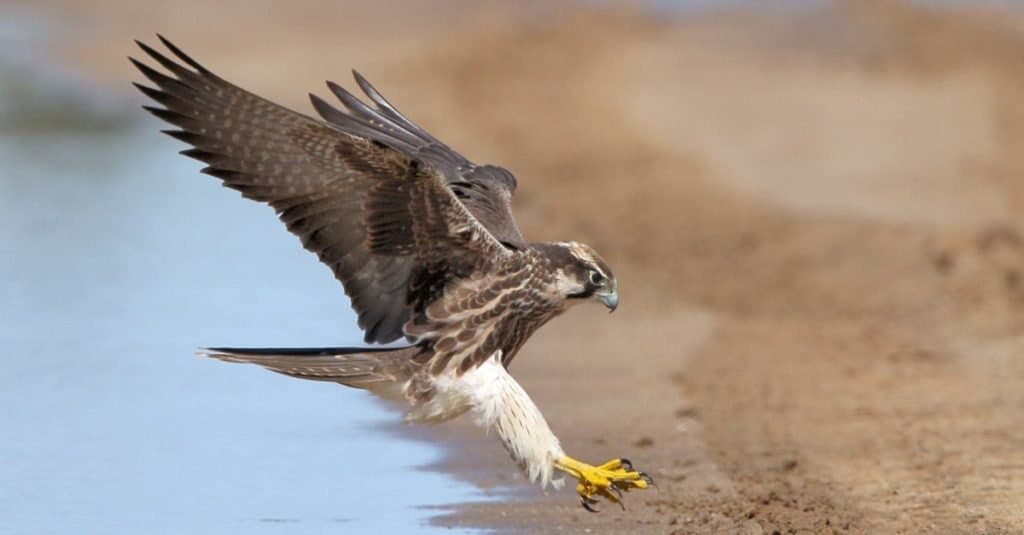
©Neal Cooper/Shutterstock.com
Diet
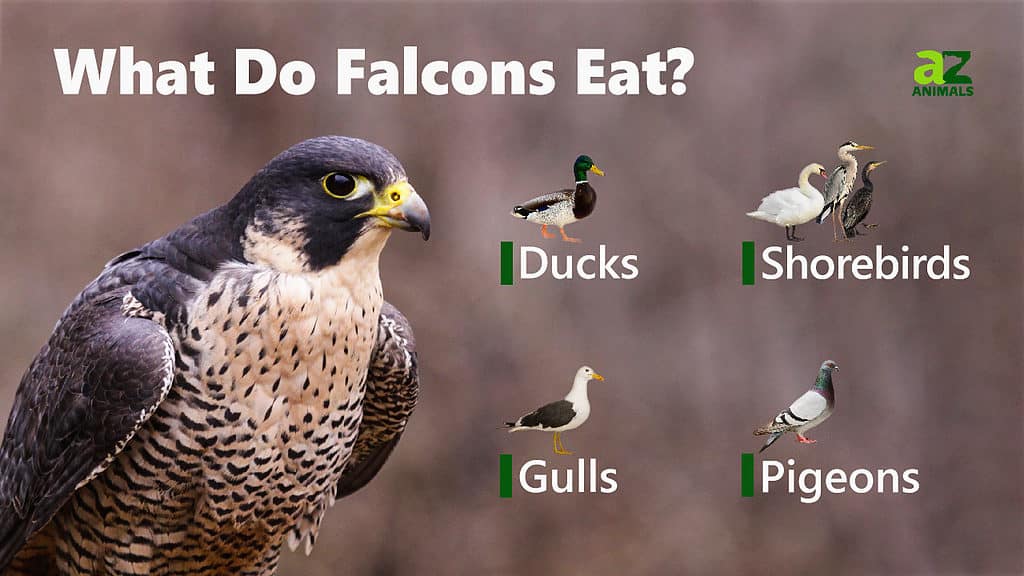
These birds are carnivorous, meaning that they primarily consume meat in their diet. The sources of nutrients that they prefer will vary from species to species, but they are not picky; most often, they will just seek out food that is easy to catch without much work.
The falcons don’t often go after the big games. Rodents, small reptiles, and small amphibians are the most common sources of nutrients.
Predators and Threats
Like many living creatures, these birds tend to have their own slew of predators and other threats to their life. Though their predatory characteristics keep them rather high on the food chain, humans and wolves are both dangers to the falcon bird population.
Large owls will seek out the birds that are still young and inexperienced in their defenses. However, more often than not, animals that prey on falcons will consume their eggs and young for a smaller challenge, as they cannot protect themselves without the help of their parents yet.
Though these birds are considered to be at the “least concern” on the endangered species list, there are still many laws that protect these birds (along with hawks and eagles) from being hunted as meat.
What Does a Falcon Bird Eat?
The food sources that these birds eat are entirely dependent on what they can lift and what they can catch. As speedy as most rodents are, falcons will seek out mice, rats, and even rabbits. If another bird is small enough to be caught in the sharp beak of the falcon, these birds will seek them out as well.
Additionally, they consume snakes and frogs, despite the defenses that these animals may have against predators.
What Eats Falcons?
As stated above, wolves and large owls have been known to go after falcons as food. However, they are not often the prey in the wild.
Even though humans are a threat, most sources say that it is not good to eat them. Their bodies do not often have any fat, due to their physical activity, making the meat rather dry. Furthermore, the primary concern with consuming falcon meat is due to the legal issues around hunting the birds.
The Bird’s Reproduction, Babies, and Lifespan

Chick falco peregrine. Yamal, Russia.
©Fufachew Ivan Andreevich/Shutterstock.com
Most of the falcon bird species are monogamous which means that they have one mating partner. They usually mark territories around their nesting sites at the time of mating.
Female falcons take full responsibility for the incubation of babies known as chicks. They take care of the babies while the male falcons hunt for food.
Each cluster contains about two to four eggs. The incubation of falcon babies lasts about a month. However, different species of falcon babies take different amounts of time to start flying.
On average, falcons live for about 13 years. At most, they live for about 16 to 20 years.
Population
The total number of falcons around the world is currently unknown, but their conservation status is considered to be “least concern” overall. The most recent estimates suggest that there are about 140,000 falcons in the world.
The peregrine falcon, however, was formerly considered endangered when certain pesticides were used over 50 years ago, killing much of the population.
Since DDT – one of the deadliest pesticides – was banned, peregrine falcons have flourished, and their nesting areas are now protected.
View all 91 animals that start with FFalcon FAQs (Frequently Asked Questions)
Are Falcons herbivores, carnivores, or omnivores?
Falcons are Carnivores, meaning they eat other animals.
What Kingdom do Falcons belong to?
Falcons belong to the Kingdom Animalia.
What class do Falcons belong to?
Falcons belong to the class Aves.
What phylum to Falcons belong to?
Falcons belong to the phylum Chordata.
What is a falcon?
Falcon is a small to medium-sized prey bird that is known to be very fast in catching its prey.
How many types of falcons are there?
There are 40 different species of falcons in the world.
Where are falcons found?
Different species of falcons are found in a variety of places including Alaska, Hawaii, and New York City.
Is a falcon a hawk?
While falcons and hawks are closely related, there are some differences between the two.
Are falcons dangerous?
Falcons attack humans and other birds and animals only when they sense a danger to their nests.
Do falcons migrate?
Some species of falcons are known to be seasonal migrators.
How many eggs do falcons lay?
Every cluster has about two to four eggs.
How fast does a falcon fly?
Falcons are known to fly at a speed of 242 mph.
What is a falcon’s wingspan?
The wingspan of some of the falcons is about 74 to 120 cm.
When do falcons leave the nest?
Different species of falcons take different amounts of time to leave their nests.
What family do Falcons belong to?
Falcons belong to the family Falconidae.
What order do Falcons belong to?
Falcons belong to the order Falconiformes.
What type of covering do Falcons have?
Falcons are covered in Feathers.
What genus do Falcons belong to?
Falcons belong to the genus Falco.
What is the main prey for Falcons?
Falcons prey on birds, rabbits, and bats.
What are some predators of Falcons?
Predators of Falcons include humans, eagles, owls, and wolves.
What are some distinguishing features of Falcons?
Falcons have sharp, pointed beaks and aerodynamic body shapes.
What is an interesting fact about Falcons?
Falcons are the fastest creatures on the planet!
What is the lifespan of a Falcon?
Falcons can live for 12 to 18 years.
What is the Falcon's wingspan?
The Falcon has a wingspan of 74 to 120 cm.
How do Falcons have babies?
Falcons lay eggs.
Thank you for reading! Have some feedback for us? Contact the AZ Animals editorial team.
Sources
- Study / Accessed January 3, 2021
- Animals.mom / Accessed January 3, 2021
- National Geographic / Accessed January 3, 2021
- Sciencing / Accessed January 3, 2021
- Animals / Accessed January 3, 2021
- All About Birds / Accessed January 3, 2021
- Wikipedia / Accessed January 3, 2021

